
Let’s be honest – most yoga guides make this sound way more complicated than it needs to be. Here’s the truth: You can absolutely practice Kriya Yoga at home without turning your life upside down. In fact, I’ve been doing it for years between work meetings and laundry loads.
First things first, forget the Instagram-perfect images. Instead, focus on these key elements:
- Your Space
Now, you don’t need a dedicated meditation room. Simply find:
- That chair where you throw your clothes (just clear it first)
- Your bed before sleeping (bonus: you’re already there)
- Even your parked car during lunch break
The trick is consistency, not aesthetics.
- The Breathing
Here’s where most beginners overcomplicate things. Start with this simple pattern:
- Inhale for 4 counts (like smelling fresh coffee)
- Hold for 2 (optional)
- Exhale for 6 (like blowing out candles)
Repeat 5 times. That’s it – no advanced techniques yet.
- The Mindset
Here’s the hard truth: Your mind will wander. When (not if) this happens:
- First, notice you’re distracted
- Then, gently return to breathing
- Finally, resist judging yourself
Remember, even seasoned practitioners get distracted.
Why This Approach Works
Over time, you’ll notice:
- First, better stress management
- Next, improved focus
- Eventually, more emotional balance
But here’s the key – progress comes from regular practice, not perfect sessions.
Getting Started Today
- First, pick your spot
- Next, set a 5-minute timer
- Then, do the breathing exercise
- Finally, notice how you feel
Pro tip: If you forget one day, simply start again tomorrow. No guilt, no drama.
Kriya Yoga Safety Talk (From Someone Who Learned the Hard Way)
Let’s get real – I screwed up big time when I first started Kriya Yoga. I ignored all the warning signs because I was so determined to “get it right.” Ended up lightheaded, anxious, and frustrated. Now I want to save you from repeating my ignorant mistakes.
Who Should Take It Extra Slow:
• Heart condition folks (learned this lesson watching my uncle struggle)
• Anxiety sufferers (some breaths can accidentally trigger panic)
• Asthma people (certain techniques feel like breathing through a coffee stirrer)
• pregnant people (your body’s already doing enough work)
Red Flags I Stupidly Ignored:
That “spaced out” feeling? Not enlightenment – it’s your brain saying “hey dummy, I need oxygen!”
Headaches? Your body’s way of screaming “STOP!”
Feeling worse after practice? Means you did it wrong.
Finding a Real Teacher (Not a Scammer):
After wasting rent money on a so-called mentor who turned out to be a con artist, here’s what I learned about legit teachers:
- They grill you about your health history BEFORE taking your money
- They admit this isn’t magic – just a tool
- They can show actual credentials from real organizations
The Cold Hard Truth:
This practice changed my life – when I finally started doing it safely. Your experience will be different. If something feels off, it probably is. Listen to that instinct.
(Pro tip: If a teacher says Kriya can replace your meds? Run. Fast.)
What is Kriya Yoga? (And Why Try It at Home?)
Let’s cut through the spiritual jargon. Kriya Yoga is like a mental gym membership – except instead of six-pack abs, you get inner peace and clarity.
The Basics:
- Controlled breathing that actually does something
- Meditation with structure (no “just clear your mind” nonsense)
- Energy work that feels real, not woo-woo
History Lesson:
This isn’t some Instagram trend. Kriya Yoga comes from ancient Indian traditions, got popularized by Yogananda (that yogi author Steve Jobs loved), and has been helping average people ever since.
Why Bother?
In our distracted world, Kriya Yoga gives you:
- Mental space to think clearly
- Emotional resilience when life gets messy
- A way to unplug that actually works
Where to Learn Properly:
Organizations like the Self-Realization Fellowship teach the authentic practice – important because watered-down versions miss the point.
(Pro tip: It’s simple to learn but takes practice to master, like anything worthwhile.)
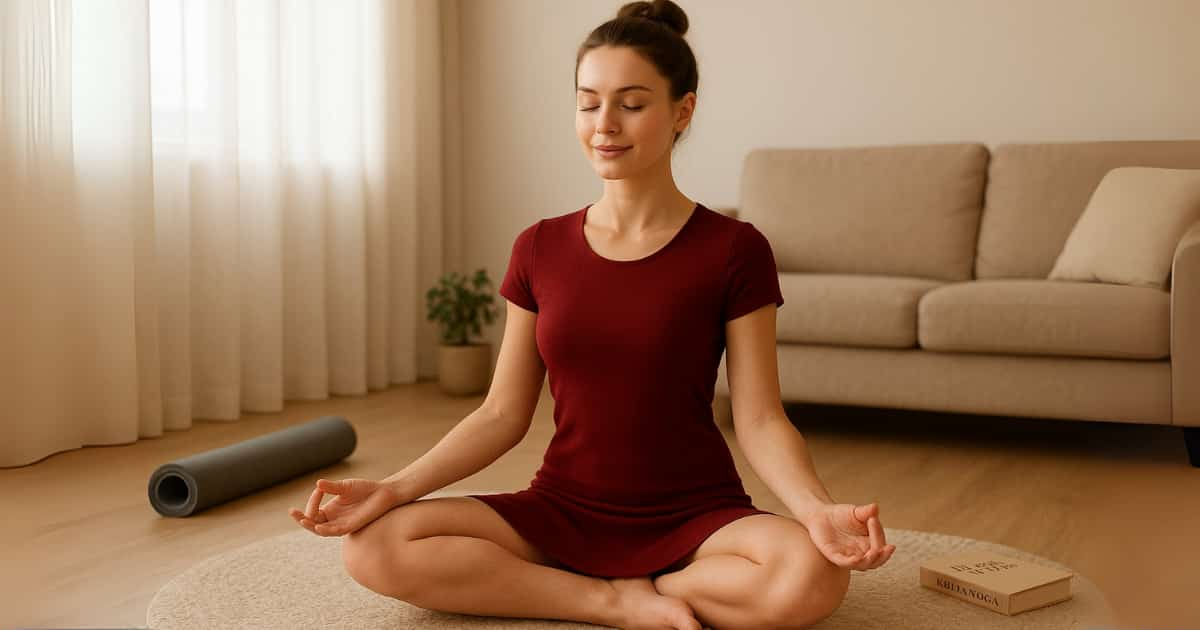
The Basics of Kriya Yoga
- Breath Control – First, you learn to breathe like a pro, balancing your energy and calming the mind. (By the way, it’s not just “inhale-exhale-repeat”—there’s a method to the madness.)
- Moving Prana – Next, you guide your life force energy (prana) through your chakras (those spinning energy centers in your body). Basically, imagine it like an inner energy highway—traffic jams not allowed.
- Silent Meditation – Finally, you sit quietly, connect with your higher self, and—if you’re lucky—avoid falling asleep (because, let’s be real, we’ve all been there).
Kriya Yoga isn’t about forcing anything; instead, it’s about flowing with your breath and energy. Plus, if ancient yogis and modern seekers swear by it, maybe it’s worth a try? (Just saying.)
(Pro tip: If your mind wanders during practice, don’t worry—even yogis get distracted sometimes. The key is to gently bring it back.)
Can You Practice Kriya Yoga at Home? (Spoiler: Yes, and Here’s How!)
First things first: Yes, you totally can! Now, while getting proper initiation from a teacher is ideal (sort of like having GPS for your spiritual journey), you can definitely begin with basic techniques at home. Just remember – this isn’t microwave enlightenment we’re talking about here.
Here’s Why Home Practice Works So Well
- Privacy & Peace – First of all, you get to avoid those awkward beginner moments (we’ve all been the person who sneezed during silent meditation). Plus, you can make all the weird faces you want without judgment.
- Flexible Timing – Meanwhile, in a studio class, you’re stuck with their schedule. At home? Feel like practicing at 2 AM? Go for it. After all, pajama yoga should be an Olympic sport.
- Personal Sacred Space – Not only can you decorate it however you like, but you also don’t have to share your favorite spot with anyone. That said, if your dog/cat/kid decides to join, consider it bonus mindfulness training.
Important Note: While starting at home is great, eventually you might want guidance. Think of it like learning to cook – you can make toast alone, but for the fancy stuff, recipes help.
Final Thought: Home practice = convenient, personal, and surprisingly effective. Just add patience (and maybe some comfy pants).
P.S. If your mind wanders (and it will), don’t stress. Even the Dalai Lama probably thinks about lunch sometimes during meditation. The trick is gently bringing your focus back – like training a puppy, but for your brain
Bottom Line: Home practice = convenient, personal, and totally valid. Just add consistency (and maybe snacks for after)
How to Prepare for Home Practice
First rule: Don’t overthink it. Your practice space doesn’t need Himalayan salt lamps and chanting monks (unless that’s your thing). Here’s the no-nonsense guide:
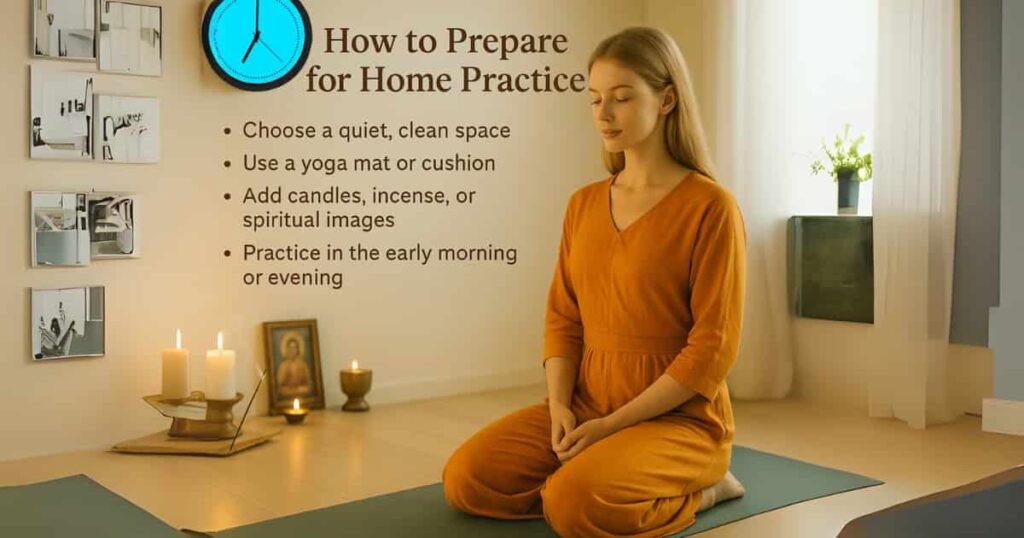
- Find Your Quiet Corner
- Ideally somewhere you won’t be interrupted by kids, pets, or Netflix notifications
- Pro tip: The bathroom counts if it’s your only peaceful spot (we won’t judge)
- Comfort is Key
- Grab a yoga mat or at least a cushion – your knees will thank you later
- Warning: That old college beanbag might seem comfy until you’re stuck in it
- Keep It Simple (But Not Boring)
- A candle or incense can set the mood without becoming a fire hazard
- Bonus: Spiritual images optional – your cat staring at you works too
- Timing is Everything
- Mornings = fresh mind (but coffee first, let’s be real)
- Evenings = stress relief (perfect after a day of adulting)
Remember: The best space is the one you’ll actually use. So if your “sacred space” is just a cleared-off corner of your bedroom – perfect. Now go practice before you overthink the décor!
P.S. If your family asks why you’re sitting weird, just say you’re “charging your chakras.” Works every time.
How to Do Kriya Yoga at Home: A Simple and Effective Practice
A. Setting Up Your Home Kriya Yoga Space
Let’s be honest – between your dog begging for treats and your phone constantly buzzing, finding focus feels impossible. However, here’s the good news: with a few simple steps, you can create an instant focus zone.
First, identify your spot:
- Ideally, find a quiet corner (even a closet works in a pinch)
- Then, firmly tell others “Do not disturb” (a serious finger wag helps)
- Finally, position yourself facing away from the fridge (because let’s face it, snack temptation is real)
Next, make it feel special:
- Start by lowering the lights (or try a sleep mask for instant calm)
- After that, add just one cozy item (a cushion or soft blanket works perfectly)
- Optionally, light a candle if you enjoy it (though this is purely optional)
Here’s why this setup matters:
- When you use the same spot regularly, your brain quickly associates it with focus
- Similarly, keeping it simple prevents it from feeling like a chore
- Most importantly, removing obvious distractions creates instant results
For example, that folded sweater? It doubles perfectly as a meditation cushion when needed. In other words, you don’t need special equipment – you just need consistency.
Pro tip: If your mind still wanders at first, don’t worry. Instead, gently guide it back each time. Over time, you’ll find focus comes more easily in your special zone.
B. The Beginner’s Kriya Yoga Sequence (Step-by-Step for Home Practice)
Let’s cut to the chase – Kriya Yoga isn’t about becoming a human pretzel or memorizing ancient chants. I used to think you needed to be some enlightened mentor to start, but here’s the truth: this practice meets you exactly where you’re at. Whether you’re sitting in pajamas or just finished your morning coffee, here’s how real people actually begin:
Step 1: Get Grounded (1–2 minutes)
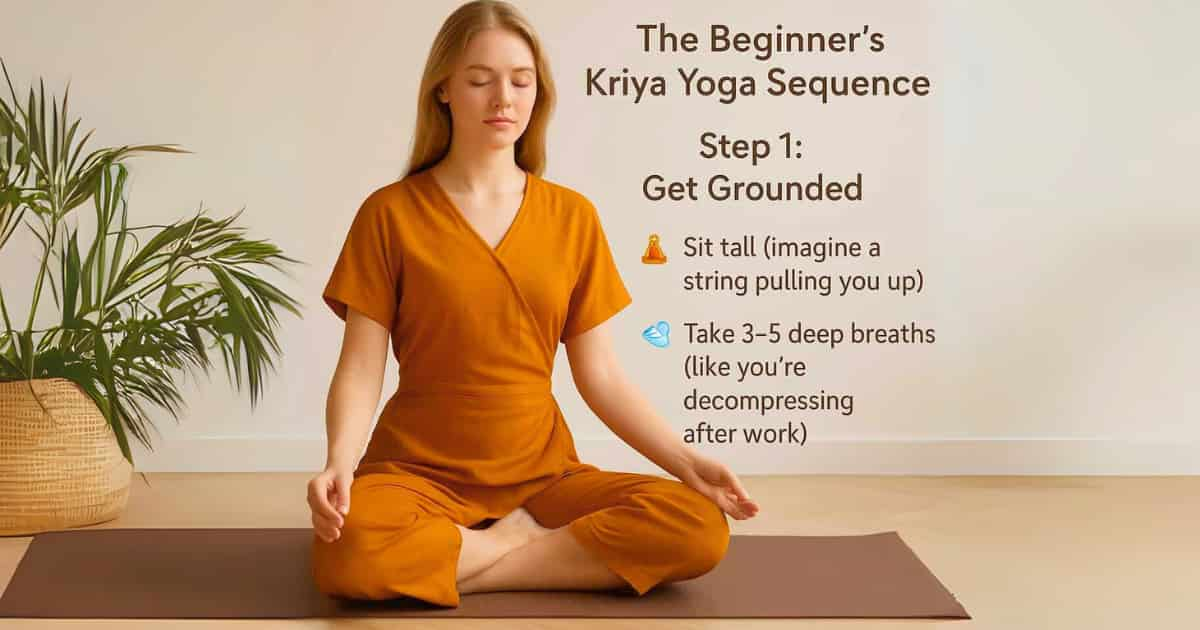
Let me tell you how I actually practice Kriya Yoga in my real, messy life – not the picture-perfect version you see on Instagram.
Finding Your Spot
My “meditation space” is usually:
- The driver’s seat of my car before work
- A corner of the couch after the kids are in bed
- Sometimes even the bathroom when I need 5 minutes alone
Sitting (Sort Of)
I don’t do lotus position – that’s for people without bad knees. I:
- Sit cross-legged if I’m on the floor
- Use a pillow under my hips if my back hurts
- In a chair when I’m tired (which is often)
The Breathing Part
Here’s my no-fail method:
- Inhale while counting to 4 (like smelling coffee)
- Hold for 2 counts
- Exhale for 6 counts (like blowing out birthday candles)
When My Mind Wanders
Which it does. Constantly. I:
- Notice I’m thinking about groceries
- Smile at myself (no judgment)
- Gently return to counting breaths
Why This Works for Me
- No fancy equipment needed
- Can do it anywhere
- Even 3 minutes makes a difference
- Gets easier with practice (but never perfect)
The secret? Just showing up. Some days I feel zen. Other days my brain won’t quit. Both count as practice.
Want to try? Start with 2 minutes today. No special clothes or candles required. Just you and your breath.
Why Bother?
This simple routine tells your overworked brain: “Hey, we’re taking a breather.” Even 60 seconds helps reset your system.
(Protip: If your mind wanders to your grocery list – totally normal. Just come back to the cookies-breathing.)
Step 2: Become Best Friends with Your Breath (2–3 minutes)

Easy Breezy Breathing Practice
Just notice your normal breathing. Feel that? Air feels cool going in, warm coming out. That’s your anchor.
Your mind will wander (probably to what’s for lunch). No big deal. Just guide it back to your breath, like calling a puppy back inside.
No need to force anything. No grading yourself. Just notice what’s already happening.
Helpful image: Picture your breath like ocean waves – some small, some big, but always moving.
Step 3: Alternate Nostril Breathing (Nadi Shodhana) – Your Secret Reset (3–5 minutes)
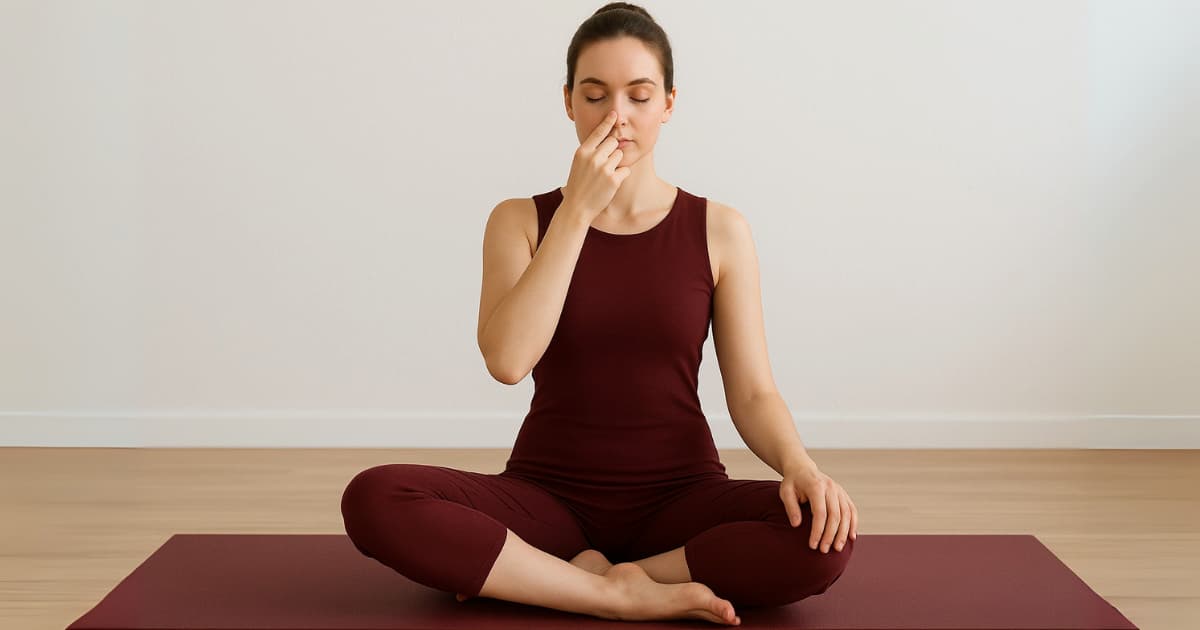
Let me break down this simple breathing trick that yoga teachers love. It’s like a reset button for your brain.
Here’s How Normal People Do It:
1. Find Your Seat
- Sit however doesn’t make your legs scream in 2 minutes (chair/couch/floor all work)
- Back mostly straight, but think “proud” not “military inspection”
- Shoulders down – imagine they’re heavy sandbags, not floating up to your ears
2. The Nose Tap Dance
- Right thumb gently presses right nostril closed (no need to squish it shut)
- Breathe in slow through the left side – like you’re smelling morning coffee brewing
- Pause just a second at the top (that’s the good stuff)
3. The Switch-Up
- Release thumb, use ring finger to lightly close left nostril
- Breathe out right side like you’re fogging up a window
- Now breathe IN right side (suddenly that nostril’s your best friend)
- Switch and exhale left
4. Make It Your Own
- Do 5-10 rounds total – no gold stars for more
- If you mess up the fingers? Totally normal. I still do sometimes.
- Feel that weird calm after? That’s the magic. No Sanskrit required
Do this 5-10 times. Congrats, you did yoga!
Important Safety Stuff:
If you feel:
- Dizzy → Stop
- Panicky → Stop
- Anything weird → Stop
Normal breathing is always available. No shame in tapping out.
Why This Rocks:
- Calms anxiety fast
- Balances your energy
- Helps when you can’t sleep
(Pro Tip: If your arm gets tired, rest it. This isn’t an arm workout.)
Step 4: Simple Kriya Meditation (5–10 minutes)
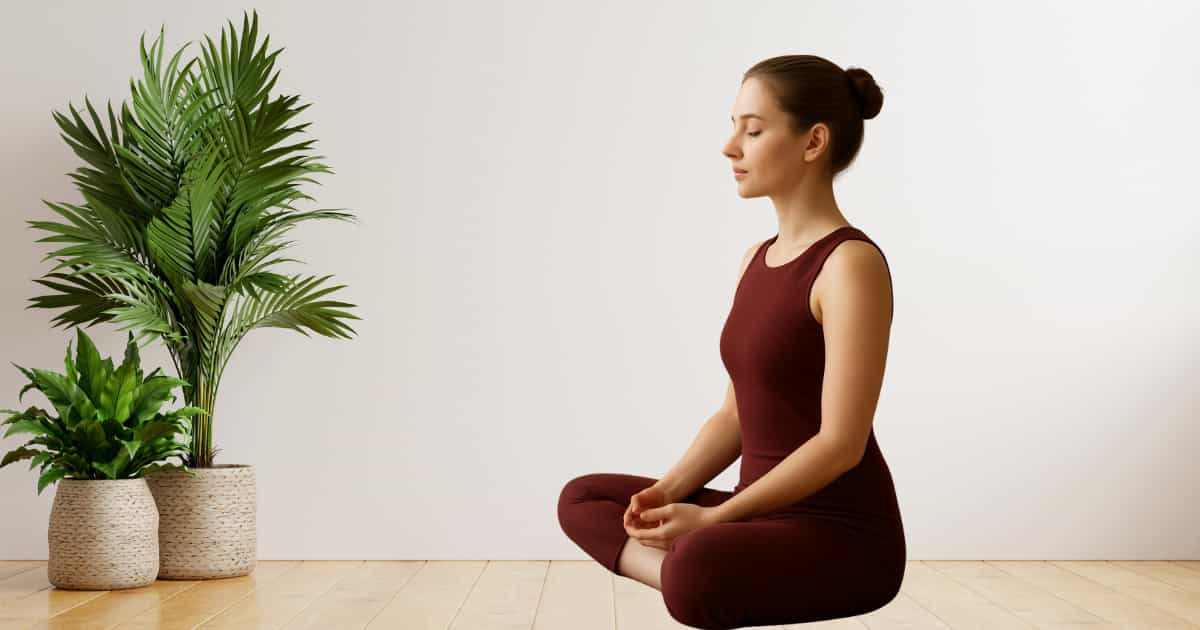
Okay, you’re breathing steady – time to try meditating. Don’t worry, this isn’t about emptying your mind (that’s impossible). Here’s how normal humans do it:
The Easy Version:
- Sit Tall-ish
Back reasonably straight (but comfortable)
Imagine a warm light between your eyebrows - The Mantra Part
Silently say “So” when breathing in
Say “Hum” when breathing out
(It means “I am” but translation doesn’t matter) - When Your Brain Won’t Shut Up
Thoughts will crash in like uninvited guests
Gently return to “So Hum” each time
Pro Tips for Fidgety Folks:
- Start with 2 minutes (seriously, set a timer)
- It’s okay if you think about dinner plans
- No such thing as “bad meditation”
Why Bother?
- Helps you pause before snapping at people
- Makes stressful moments less intense
- Gives your busy brain a coffee break
(First time? You’ll probably hate it. Tenth time? You might crave it.)
C. Making Kriya Yoga Work in Your Real Life
- Morning person? Try sunrise sessions
- Night owl? Wind down with evening practice
- Short on time? Even 10 minutes counts
Pro Tip: Consistency > perfection. Missed a day? Just start again tomorrow.
Remember: This is your practice – no yoga police will ticket you for modifications.
Now go forth and breathe like you mean it!
P.S. If you finish without checking your phone, you’re winning at adulting.
Real Talk: How to Actually Practice Kriya Yoga at Home (Without Losing Your Mind)
1. Start Ridiculously Small (Seriously, 5 Minutes Counts)
Look, we both know you’re not gonna magically sit for an hour right away. So set a timer for 5-10 minutes. Hell, even 2 minutes is better than nothing. The trick? Just show up. Your future zen self will thank you.
2. Make It Stupidly Consistent (Like Brushing Your Teeth)
Here’s the deal: Pick a time – morning, lunch break, whenever. Then park your butt in the same spot daily. Why? Because your brain loves routines. Before you know it, you’ll be craving this quiet time like coffee.
3. Ditch the Spiritual Perfectionism (Nobody’s Judging)
Some days your mind will wander to grocery lists. Big whoop. Instead of beating yourself up, just notice it and gently refocus. Remember: Even yogis get distracted. The difference? They just start again.
4. Keep a No-Pressure Practice Journal
After each session, scribble one line:
- “Focused for 30 seconds – new record!”
- “Mind = popcorn machine today”
This isn’t homework – it’s just to notice patterns over time.
5. Learn More When YOU Feel Ready
Right now? Just breathe. Later? Maybe check out that book gathering dust. But don’t overwhelm yourself trying to become a Kriya scholar overnight.
The Real Secret: Progress beats perfection every damn time. So if you manage to sit and breathe for a few minutes without checking your phone? Congratulations, you’re doing Kriya Yoga at home.
P.S. If you “fail” today? Guess what – tomorrow’s a new chance. This is how real practice works.
P.P.S. That “sacred space” can literally be a corner of your bedroom. Stop overcomplicating it. Now go practice.
Kriya Yoga at Home: 4 Mistakes That’ll Screw Up Your Practice (And How to Avoid Them)
1. Skipping Meditation (Because Breathing Feels Easier)
Let’s be real—breathing exercises are straightforward, whereas sitting in silence can feel awkward. But here’s the catch: Pranayama only preps your system—meditation is where the real transformation happens. So next time, force yourself to sit those extra 5 minutes. Otherwise, you’re just doing fancy breathwork.
2. Jumping Into Advanced Techniques (Slow Down, Tiger)
Sure, those flashy Kriya techniques look impressive. However, without proper foundation? That’s like trying to sprint before learning to walk. Instead, master the basics first—breath awareness, gentle pranayama, short meditations. Then, when your teacher says you’re ready, that’s your green light.
3. Practicing “Whenever” (AKA Never)
Newsflash: Motivation is flaky. That’s why you need a non-negotiable schedule. Whether it’s mornings before coffee or right before bed, pick a time and guard it like your sanity depends on it (because, let’s face it, it kinda does). Even if some sessions are short, at least they’re happening.
4. Overanalyzing Every Little Sensation (Stop It)
Look, Kriya Yoga isn’t a performance review. Some days you’ll feel deep peace; other days, your brain will replay that embarrassing thing you did in 2012. The key? Observe without judging. Remember, the practice works even when it feels like nothing’s happening.
Pro Tip: When you catch yourself slipping into these traps (and you will), don’t stress. Just gently course-correct. After all, even seasoned yogis face these hurdles
Where to Go When You’re Ready to Level Up
Autobiography of a Yogi by Paramahansa Yogananda
The Kriya Yoga Institute (kriya.org)
Frequently Asked Questions (FAQ)
Start with 15-30 minutes (breathing + meditation). That’s less time than your morning scroll session. Pro tip: Can’t sit still? Do 5 minutes without checking your phone. Baby steps.
Basics? Go wild. Advanced stuff? Pump the brakes. Kriya Pranayama = “learn from a pro” territory. Unless you enjoy energy headaches. (You don’t.)
Hell yes. Start with:
Watching your breath (like a creepy stalker)
Alternate nostril breathing (fancy but easy)
Sitting quietly (harder than it sounds)
Sunrise/sunset = golden hours. But if you’re not a morning person? Just pick a time you won’t bail. Hint: Not during Netflix time.
Nope. Benefits work whether you’re spiritual, atheist, or just “trying not to lose it.” No chanting required (unless you want to).
P.S. If you overthink this? Congratulations, you’re human. Now go practice.
Final Thoughts
Here’s the raw truth no one tells you about Kriya Yoga – it’s not about becoming some picture-perfect mentor,. What’s far more valuable? Those tiny moments of stillness you sneak into daily life.
Let me explain why this matters:
When I first started, I kept waiting for some big spiritual awakening. But you know what actually changed things? That time I caught myself taking three conscious breaths before yelling at my computer. Or when I paused to center myself instead of reacting to my kid’s tantrum.
Here’s what I’ve learned:
- The magic isn’t in achieving enlightenment
- It’s in creating small oases of calm in your chaos
- These moments compound quietly until one day you realize you’re different
The real transformation happens when:
You’re stuck in traffic and instinctively breathe through frustration
You wake up anxious but know how to ground yourself
You face a crisis with unexpected steadiness
That’s the actual value – not looking spiritual, but being more present in your messy, beautiful, ordinary life.
🔗 Love mindful living? Follow us on Pinterest and LinkedIn for daily meditation tips, peaceful visuals, and more
🧭 Explore More on Yoga





55 yr. Male no Kids, never marriied all but the 4th Chakras are open knowlege of the 13 and 114 chakra system with the Zodiac 13 months moon cycle 28days .Looking 4 a female too practice kundilini meditation ?tantric yoga mutual massage sharing yoni for her if mutual communication their.
Thank you for sharing your deep understanding of chakra systems and celestial cycles—it’s clear you’ve invested time in this wisdom! The 13- and 114-chakra frameworks are fascinating, especially when woven with lunar rhythms.
Since you’re exploring the sacral chakra’s role in connection, you might find value in my recent guide: Sacral Chakra Meditation: Balancing Creativity & Emotional Flow. It dives into practices to harmonize this energy center, which could deepen your personal or partnered spiritual work.
For tantra or Kundalini partnerships, I’d recommend seeking communities or teachers specializing in sacred reciprocity (like tantric workshops or retreats), as these spaces often foster the grounded, respectful container such practices require.
Wishing you clarity and alignment on your journey!
https://adicreator.net/